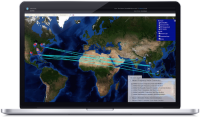Across the food and beverage industry, organizations are undertaking a wide variety of data-oriented technology initiatives. There are a host of reasons for the trend, and indeed the convergence of multiple factors is likely behind the growing urgency for digitization within many food and beverage brands, manufacturers and supplier organizations. To be sure, ongoing supply chain instability over the last three or more years has put a focus on supply chain resilience and the need for more nimble and flexible supply networks. A dynamic and ever-changing global regulatory landscape is driving compliance and reporting requirements that are increasingly difficult to meet without a solid digital strategy in place. ESG initiatives are driving the need for increased visibility into global supply chains. Evolving consumer preferences create pressures on R&D organizations for continued product innovation, all of which needs to take place within acceptable safety, quality and risk management parameters. And of course, hovering over all of this is a tight (and increasingly costly) labor market, putting increased focus on opportunities for automation and increased efficiently.
Alongside these macro-level global trends, technology itself is moving forward at a rapid pace. The global food and beverage value chain has become more interconnected than ever before, with massive amounts of information moving around the world at remarkable speed. And of course, no discussion of technology is complete without a mention of artificial intelligence (AI). While by no means a new idea—many mature AI-based technologies have existed within the industry for years—AI is evolving quickly. Generative AI technologies, hardly known prior to 2023, are now appearing across the technology landscape, and dominating discussions around technology investment and strategy.
Confronted with all of this, food and beverage industry leaders could be forgiven for feeling a bit overwhelmed. Not only is more information (some valuable, some less so) available than ever before, but a profusion of technology solutions are vying for attention, nearly all promising new levels of insight and productivity. The landscape is complex, but there are a few basic steps that teams can take to help ensure that any potential technology investments are pointed in the right direction and are set up for long term success. Let’s examine five basic, but important steps that can help guide digitization efforts to a strong outcome.

1. Starting with the end in mind. The objective of a technology implementation should never be to implement a platform. Usually, technology investments start with a business problem that needs to be solved. For food safety teams, this can encompass a range of possibilities, from a desire to reduce error and gain efficiencies in processes, to a need for better real-time monitoring of processes already in place, to a desire to decrease global risk exposure in an increasingly diverse supplier environment. Whatever the situation, teams can substantially de-risk technology investments by being crystal clear on the business objectives (not simply the implementation goals) of a given initiative. Clearly defining a “north star” in terms of expected business outcomes, and revisiting those goals often, can help keep projects focused, and avoid costly missteps and poor prioritization decisions along the way.
2. Defining stakeholders. Though seemingly obvious, it can be surprisingly easy for teams to launch an initiative without a clear view of impacted stakeholders. Typically, a given technology solution will have relatively well-understood functional owners within an organization. But it’s equally important to understand downstream groups that may have to interact with the solution or its outputs. Direct users, too, are a stakeholder community that can easily be overlooked. A solution that does its job on paper but doesn’t align with the working conditions of an end-user community is going to run into challenges. External stakeholders may also need to be considered, as suppliers, customers, contract manufacturers and other entities can all become obstacles to program success if their buy-in hasn’t been considered early in the process.
3. Supplementing (vs. replacing) human intelligence. With all the buzz around AI, it’s easy to get excited about the longer-term possibilities of the technology. And that’s appropriate – AI has already had notable effects on industry technologies and will continue to do so in the years to come. But it’s equally important to consider the current state of generative AI solutions, and be realistic about the limitations and risks of the technology as it exists today. A useful framework for this approach can be to think in terms of how AI can help supplement, even maximize, the intelligence and expertise of human users. Can it consolidate data that would be cumbersome to organize and collate? Can it scan information and flag likely priorities for further investigation?
In the high-stakes environment of food safety and quality, the overlay of hard-earned human knowledge and awareness is going to remain necessary for a long time to come. At the same time, AI-based solutions are already present in the space, and those who use them wisely may very well realize a significant market advantage over those who shy away entirely.
4. Getting real about data quality. Whether the discussion is about AI, data insights, analytics, compliance reporting or automation, most technologies run on data. Put another way, most technologies aren’t any better than the data they consume. The ancient saying, “garbage in, garbage out” remains depressingly current, many decades after the dawn of computing. As a result, it’s important to take a hard look at the quality, completeness, consistency and structure of the information that a potential technology solution will need to access in order to deliver on its promise. On the positive side, qualified technology providers should be able to provide assistance and clear guidance through the data side of any implementation, and in an increasingly networked world, providers may even be able to come to the table with useful industry data and data management practices that make this part of the digitization journey easier and faster. But it’s important not to skip this step; many are the solutions that never lived up to their potential because the data they needed to consume wasn’t workable.
5. Lastly, as initiatives come together, it’s important to loop back to the original business objectives that were clarified in the first step. Have those objectives been met and, crucially, can that be measured? If it can, the project has likely succeeded, and is positioned to yield insights toward the next step in the technology journey.
The good news is that as digitization continues across the food and beverage industry, it creates a greater opportunity for brands, manufacturers and suppliers to move away from the antiquated model of static, linear supply chains, and toward a more interconnected future based both on shared data and shared values. Explore the world’s largest network of F&B brands and suppliers at TraceGains Gather™, and learn more about the growing community of committed safety professionals worldwide.








